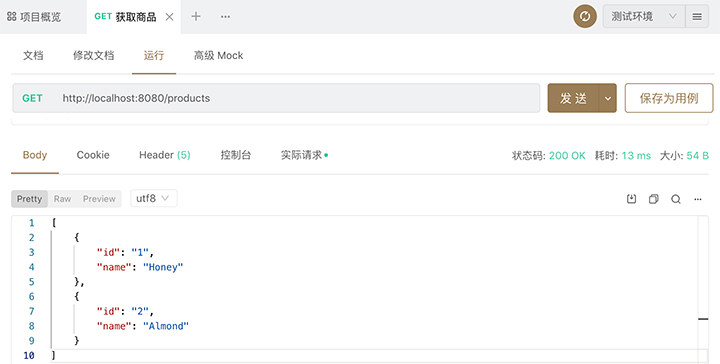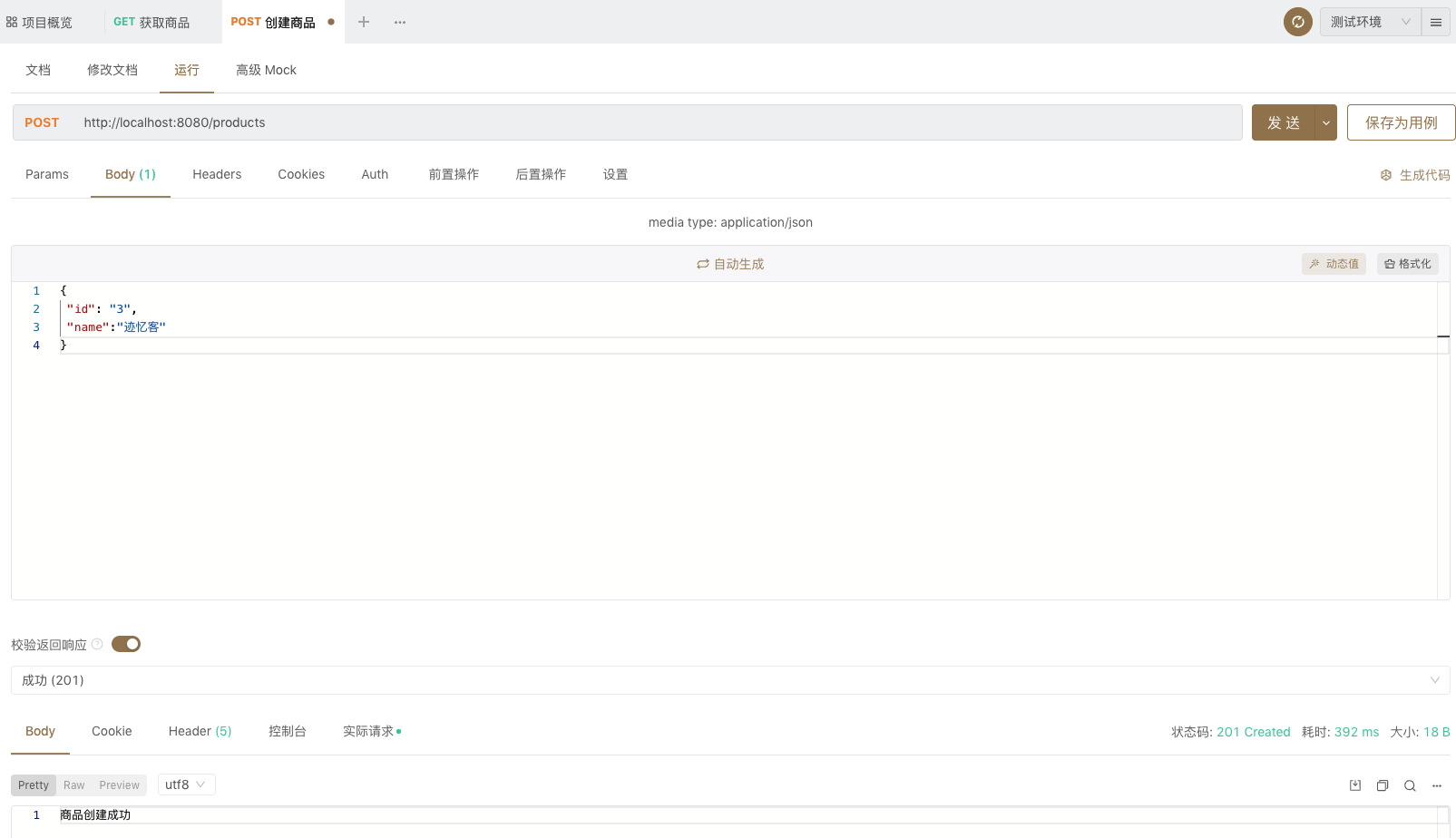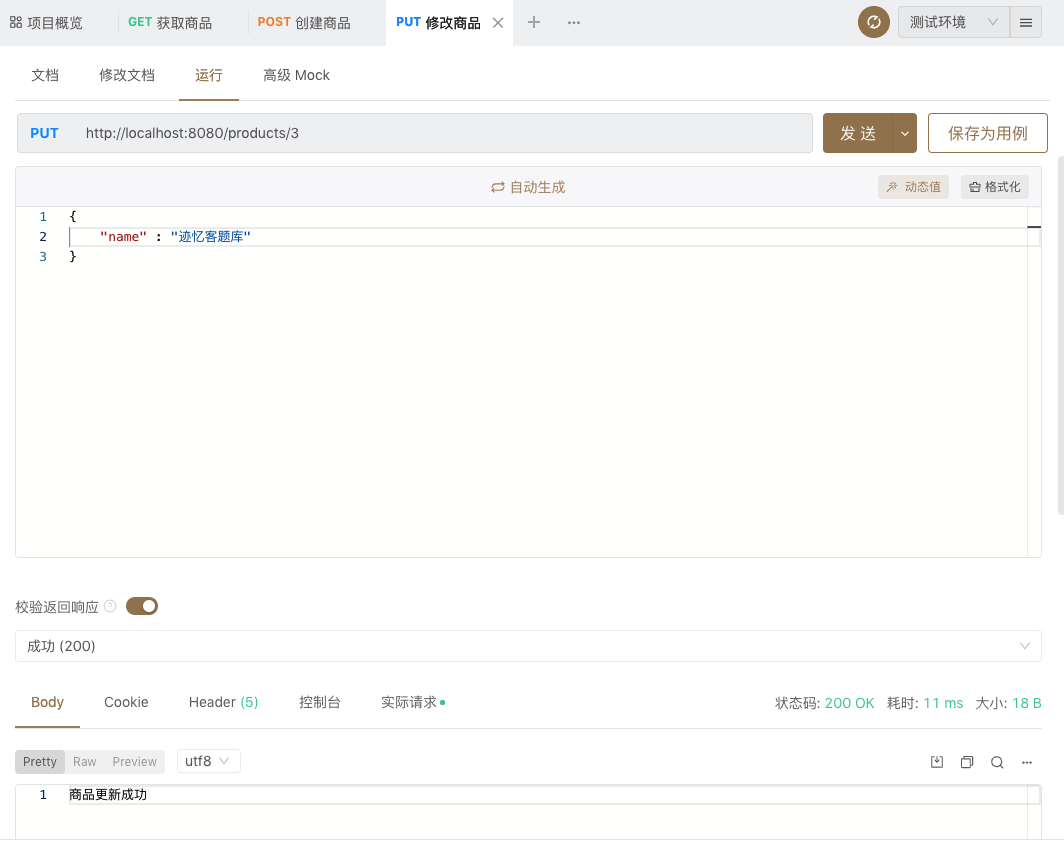Spring Boot Rest Template
Rest Template 用于创建使用 RESTful Web 服务的应用程序。 我们可以使用 exchange() 方法为所有 HTTP 方法使用 Web 服务。下面给出的代码显示了如何为 Rest Template 创建 Bean 以自动连接 Rest Template 对象。
@SpringBootApplication
public class MyApplication {
public static void main(String[] args) {
SpringApplication.run(MyApplication.class, args);
}
@Bean
public RestTemplate getRestTemplate() {
return new RestTemplate();
}
}
GET
使用 RestTemplate - exchange() 方法使用 GET API
假设此 URL http://localhost:8080/products 返回以下 JSON,我们将使用以下代码通过 Rest Template 使用此 API 响应
[
{
"id": "1",
"name": "Honey"
},
{
"id": "2",
"name": "Almond"
}
]
我们必须按照给定的要点来使用 API
- 自动装配 Rest 模板对象。
- 使用 HttpHeaders 设置请求标头。
- 使用 HttpEntity 封装请求对象。
- 为 Exchange() 方法提供 URL、HttpMethod 和返回类型。
@RestController
public class ConsumeWebService {
@Autowired
RestTemplate restTemplate;
@RequestMapping(value = "/template/products")
public String getProductList() {
HttpHeaders headers = new HttpHeaders();
headers.setAccept(Arrays.asList(MediaType.APPLICATION_JSON));
HttpEntity <String> entity = new HttpEntity<String>(headers);
return restTemplate.exchange("
http://localhost:8080/products", HttpMethod.GET, entity, String.class).getBody();
}
}
POST
使用 RestTemplate - exchange() 方法使用 POST API
假设这个 URL http://localhost:8080/products 返回如下所示的响应,我们将使用 Rest Template 来使用这个 API 响应。
下面给出的代码是请求正文
{
"id":"3",
"name":"迹忆客"
}
下面给出的代码是响应体
商品创建成功
我们必须按照给定的要点来使用 API
- 自动装配 Rest 模板对象。
- 使用 HttpHeaders 设置请求标头。
- 使用 HttpEntity 来封装请求对象。 在这里,我们包装 Product 对象以将其发送到请求正文。
- 为 Exchange() 方法提供 URL、HttpMethod 和返回类型。
@RestController
public class ConsumeWebService {
@Autowired
RestTemplate restTemplate;
@RequestMapping(value = "/template/products", method = RequestMethod.POST)
public String createProducts(@RequestBody Product product) {
HttpHeaders headers = new HttpHeaders();
headers.setAccept(Arrays.asList(MediaType.APPLICATION_JSON));
HttpEntity<Product> entity = new HttpEntity<Product>(product,headers);
return restTemplate.exchange(
"http://localhost:8080/products", HttpMethod.POST, entity, String.class).getBody();
}
}
PUT
使用 RestTemplate - exchange() 方法使用 PUT API
假设此 URL http://localhost:8080/products/3 返回以下响应,我们将使用 Rest Template 使用此 API 响应。
下面给出的代码是请求正文
{
"name":"迹忆客题库"
}
下面给出的代码是响应体
商品更新成功
我们必须按照给定的要点来使用 API
- 自动装配 Rest 模板对象。
- 使用 HttpHeaders 设置请求标头。
- 使用 HttpEntity 来封装请求对象。 在这里,我们包装 Product 对象以将其发送到请求正文。
- 为 Exchange() 方法提供 URL、HttpMethod 和返回类型。
@RestController
public class ConsumeWebService {
@Autowired
RestTemplate restTemplate;
@RequestMapping(value = "/template/products/{id}", method = RequestMethod.PUT)
public String updateProduct(@PathVariable("id") String id, @RequestBody Product product) {
HttpHeaders headers = new HttpHeaders();
headers.setAccept(Arrays.asList(MediaType.APPLICATION_JSON));
HttpEntity<Product> entity = new HttpEntity<Product>(product,headers);
return restTemplate.exchange(
"http://localhost:8080/products/"+id, HttpMethod.PUT, entity, String.class).getBody();
}
}
DELETE
使用 RestTemplate - exchange() 方法使用 DELETE API
假设这个 URL http://localhost:8080/products/3 返回下面给出的响应,我们将使用 Rest Template 使用这个 API 响应。
下面显示的这行代码就是响应体
商品删除成功
我们必须遵循以下几点来使用 API
- 自动装配 Rest 模板对象。
- 使用 HttpHeaders 设置请求标头。
- 使用 HttpEntity 封装请求对象。
- 为 exchange() 方法提供 URL、HttpMethod 和返回类型。
@RestController
public class ConsumeWebService {
@Autowired
RestTemplate restTemplate;
@RequestMapping(value = "/template/products/{id}", method = RequestMethod.DELETE)
public String deleteProduct(@PathVariable("id") String id) {
HttpHeaders headers = new HttpHeaders();
headers.setAccept(Arrays.asList(MediaType.APPLICATION_JSON));
HttpEntity<Product> entity = new HttpEntity<Product>(headers);
return restTemplate.exchange(
"http://localhost:8080/products/"+id, HttpMethod.DELETE, entity, String.class).getBody();
}
}
下面给出了完整的 Rest Template Controller 类文件
package com.study.controller;
import com.study.model.Product;
import org.springframework.beans.factory.annotation.Autowired;
import org.springframework.http.HttpEntity;
import org.springframework.http.HttpHeaders;
import org.springframework.http.HttpMethod;
import org.springframework.http.MediaType;
import org.springframework.web.bind.annotation.*;
import org.springframework.web.client.RestTemplate;
import java.util.Arrays;
/**
* @author jiyik.com
*/
@RestController
public class ConsumeWebService {
@Autowired
RestTemplate restTemplate;
@RequestMapping(value = "/template/products")
public String getProductList() {
HttpHeaders headers = new HttpHeaders();
headers.setAccept(Arrays.asList(MediaType.APPLICATION_JSON));
HttpEntity<String> entity = new HttpEntity<String>(headers);
return restTemplate.exchange("http://localhost:8080/products", HttpMethod.GET, entity, String.class).getBody();
}
@RequestMapping(value = "/template/products", method = RequestMethod.POST)
public String createProducts(@RequestBody Product product) {
HttpHeaders headers = new HttpHeaders();
headers.setAccept(Arrays.asList(MediaType.APPLICATION_JSON));
HttpEntity<Product> entity = new HttpEntity<Product>(product, headers);
return restTemplate.exchange("http://localhost:8080/products", HttpMethod.POST, entity, String.class).getBody();
}
@RequestMapping(value = "/template/products/{id}", method = RequestMethod.PUT)
public String updateProduct(@PathVariable("id") String id, @RequestBody Product product) {
HttpHeaders headers = new HttpHeaders();
headers.setAccept(Arrays.asList(MediaType.APPLICATION_JSON));
HttpEntity<Product> entity = new HttpEntity<Product>(product, headers);
return restTemplate.exchange("http://localhost:8080/products"+id, HttpMethod.PUT, entity, String.class).getBody();
}
@RequestMapping(value = "/template/products/{id}", method = RequestMethod.DELETE)
public String deleteProduct(@PathVariable("id") String id) {
HttpHeaders headers = new HttpHeaders();
headers.setAccept(Arrays.asList(MediaType.APPLICATION_JSON));
HttpEntity<Product> entity = new HttpEntity<Product>(headers);
return restTemplate.exchange("http://localhost:8080/products"+id, HttpMethod.DELETE, entity, String.class).getBody();
}
}
Spring Boot 应用程序类 - MyApplication.java 的代码如下所示
package com.study;
import org.springframework.boot.SpringApplication;
import org.springframework.boot.autoconfigure.SpringBootApplication;
import org.springframework.context.annotation.Bean;
import org.springframework.web.client.RestTemplate;
/**
* @author jiyik.com
*/
@SpringBootApplication
public class MyApplication {
public static void main(String[] args) {
SpringApplication.run(MyApplication.class, args);
}
@Bean
public RestTemplate getRestTemplate() {
return new RestTemplate();
}
}
Maven 构建的代码 – pom.xml 如下所示
<?xml version="1.0" encoding="UTF-8"?>
<project xmlns="http://maven.apache.org/POM/4.0.0"
xmlns:xsi="http://www.w3.org/2001/XMLSchema-instance"
xsi:schemaLocation="http://maven.apache.org/POM/4.0.0 http://maven.apache.org/xsd/maven-4.0.0.xsd">
<modelVersion>4.0.0</modelVersion>
<groupId>com.spring</groupId>
<artifactId>springBootProject</artifactId>
<version>1.0-SNAPSHOT</version>
<parent>
<groupId>org.springframework.boot</groupId>
<artifactId>spring-boot-starter-parent</artifactId>
<version>2.6.6</version>
</parent>
<dependencies>
<dependency>
<groupId>org.springframework.boot</groupId>
<artifactId>spring-boot-starter-web</artifactId>
</dependency>
<dependency>
<groupId>org.springframework.boot</groupId>
<artifactId>spring-boot-starter-test</artifactId>
<scope>test</scope>
</dependency>
</dependencies>
<build>
<plugins>
<plugin>
<groupId>org.springframework.boot</groupId>
<artifactId>spring-boot-maven-plugin</artifactId>
</plugin>
</plugins>
</build>
</project>
Gradle Build - build.gradle 的代码如下
buildscript {
ext {
springBootVersion = '1.5.8.RELEASE'
}
repositories {
mavenCentral()
}
dependencies {
classpath("org.springframework.boot:spring-boot-gradle-plugin:${springBootVersion}")
}
}
apply plugin: 'java'
apply plugin: 'eclipse'
apply plugin: 'org.springframework.boot'
group = 'com.study'
version = '0.0.1-SNAPSHOT'
sourceCompatibility = 1.8
repositories {
mavenCentral()
}
dependencies {
compile('org.springframework.boot:spring-boot-starter-web')
testCompile('org.springframework.boot:spring-boot-starter-test')
}
这里我们使用 IDEA 来启动服务(读者也可以使用 mvn clean install 或者 gradle clean build 生成可执行jar包)

现在在 apifox 应用程序中点击下面显示的 URL 并查看输出。
GET API 获取商品 URL : http://localhost:8080/products

POST API 创建商品 URL : http://localhost:8080/products

PUT API 修改商品 URL : http://localhost:8080/products/3

DELETE API 删除商品 URL : http://localhost:8080/products/3

